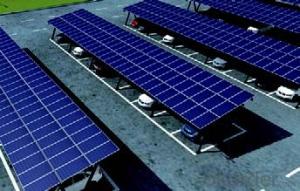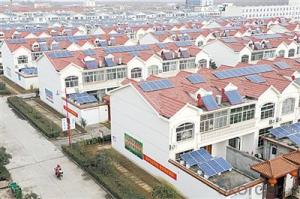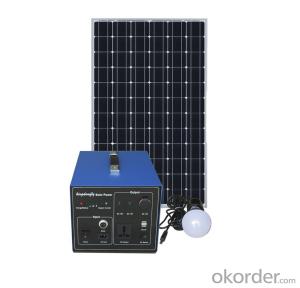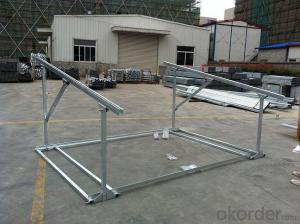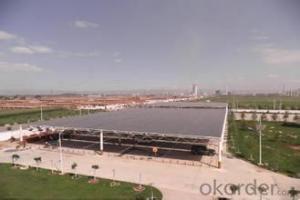Solar Energy Systems Ft Pierce Carport System Solar Mounting System
- Loading Port:
- China Main Port
- Payment Terms:
- TT OR LC
- Min Order Qty:
- -
- Supply Capability:
- -
OKorder Service Pledge
OKorder Financial Service
You Might Also Like
Packaging & Delivery
Packaging Detail:Normal package seaworthy
Delivery Detail:15 days
Specifications
Easy installation Competitive price TUV&SGS test report & CSA certification 15-warranty
Specifications
1) Super smooth beautiful appearance,outstanding quality,large supply.
2) Available in customized surface finishes.
3) Well machined,for example,cutting,drilling and milling with excellent tolerance.
4) Meet with customer’s designs and supply you best price.
5)Usages:Supply for solar panel modules.
Technical characteristics
Installation site:
ground,hillside,and grassland
Installation angle
it is based on customers’ requirements
Installation height
it is basedon customers’ requirements
Solar panel type; with or without frame
Components arrangement :horizontal or vertical
Support track
aluminum alloy extrusion
Quality warranty
15 years
Advantages
1)Quick installation: with high degree of pre-installed rate, the system could be easily installed by using galvanized carbon steel rails for PV Stent, and specially designed connection parts of the PV bracket, which could reduce installation time and cost greatly.
2)Offer unmatched durability: with all structural components comprised of high class stainless steel and anodized aluminum alloy, it is designed for 25 years service life and backed by 15 years warranty.
3)Stand up to extreme weather: The SuninTek solar mount is designed to stand up to the extreme weather complied with the AS/NZ 1170 and other international structure load standard by the skilled engineer. The main support components also have been tested to guarantee its structure and load-carrying capacity.
4)Provide broad installation flexibility: These systems accommodate most commercially available framed solar panels , and they can scale easily from small to large, multi-megawatt installations.
5)Diversified Application: The PV mounting system produced can be adopted by various types of PV cells panels which you can find in the market. It can serve for both mini solar power system and huge plant with megawatt capability.
Main features
1. Installation cost savings.
2. Save installation time.
3. Increase the mechanical strength of solar energy mounting to ensure that wind requirements.
4. The outdoor for installation of solar energy.
5. Length can be customized according to customers.
6. Service life of up to 25 years.
7. Products through the international certification.
8. Stent material composition of the galvanized steel and aluminum.
9. 15 years system and structural guarantee.
10.Flexible post spacing withstands different wind & snow loads.
11. High quality material in Aluminium 6005-T5 and SUS 304.
12.Screws and nuts go with every components needed.
13.Mechanical calculation and reliability tested to ensure highest product quality.
- Q: Can solar energy systems be used in remote areas?
- Yes, solar energy systems can be used in remote areas. They are particularly well-suited for such locations because they do not require a connection to a centralized power grid. Solar panels can be installed in remote areas to harness sunlight and generate electricity, providing a sustainable and reliable source of energy. This makes solar energy systems an ideal solution for powering remote communities, scientific research stations, or off-grid projects in isolated regions.
- Q: Do solar energy systems require regular inspections?
- Regular inspections are required for solar energy systems. These inspections are crucial to ensure optimal functioning and to detect any potential issues or maintenance requirements. They typically involve examining the condition of solar panels, evaluating the inverter's performance, inspecting electrical connections, and assessing overall system efficiency. By conducting regular inspections, problems can be detected early on, allowing for timely repairs or maintenance to prevent further damage or performance decline. Moreover, inspections may be necessary to comply with local regulations and maintain eligibility for incentives or warranties. Therefore, it is highly recommended to arrange regular inspections conducted by qualified professionals to guarantee the durability and effectiveness of solar energy systems.
- Q: How do solar energy systems impact energy resilience during natural disasters?
- Solar energy systems can greatly enhance energy resilience during natural disasters. Unlike traditional power grids that rely on fossil fuels, solar energy systems generate electricity from sunlight, making them more reliable and less vulnerable to disruptions caused by extreme weather events. During power outages, solar panels can continue to produce electricity, providing a reliable source of energy for critical infrastructure, emergency services, and households. Additionally, solar energy systems can be combined with energy storage solutions such as batteries, allowing excess energy to be stored and used when the sun is not shining, further increasing energy resilience. Overall, solar energy systems play a crucial role in ensuring a more resilient and sustainable energy infrastructure during natural disasters.
- Q: Can solar energy systems be used for powering off-grid eco-resorts?
- Yes, solar energy systems can definitely be used for powering off-grid eco-resorts. Solar panels can be installed on the roofs or in open areas of the resorts to harness sunlight and convert it into electricity. This renewable energy source can provide a sustainable and reliable power supply, allowing eco-resorts to operate independently from the grid. Additionally, solar energy systems can help reduce carbon emissions and promote eco-friendly practices in the hospitality industry.
- Q: Can solar energy systems be used in powering dental clinics or medical clinics?
- Yes, solar energy systems can be used to power dental clinics or medical clinics. Solar panels can be installed on the roofs of these facilities to capture sunlight and convert it into electricity, which can be used to meet their energy needs. This not only helps to reduce their reliance on fossil fuels but also provides a clean and sustainable source of power. Additionally, solar energy systems can be designed to store excess energy for use during non-sunlight hours, ensuring a continuous power supply for critical medical equipment and operations.
- Q: How does solar energy impact the environment?
- Solar energy has a positive impact on the environment in several ways. Firstly, it reduces greenhouse gas emissions, which are the primary cause of climate change. Solar panels generate electricity without emitting any pollutants or greenhouse gases, unlike traditional fossil fuel-based power plants. By utilizing solar energy as a clean and renewable source of power, we can significantly reduce our carbon footprint and mitigate the detrimental effects of climate change. Secondly, solar energy helps in conserving water resources. Conventional power plants, such as coal or natural gas, require vast amounts of water for cooling purposes. In contrast, solar panels do not require water for their operation, leading to a significant reduction in water consumption and the strain on local water supplies. This is especially crucial in arid regions or areas facing water scarcity. Furthermore, solar energy helps in preserving biodiversity and ecosystems. The extraction and burning of fossil fuels often result in habitat destruction and pollution, which directly harm wildlife and plant species. Solar energy, on the other hand, has minimal impact on the environment during its operation. By promoting solar energy, we can reduce the need for destructive energy practices and protect fragile ecosystems. Additionally, solar energy has a positive impact on air quality and public health. Burning fossil fuels releases harmful pollutants such as sulfur dioxide, nitrogen oxides, and particulate matter, which contribute to air pollution and respiratory diseases. By transitioning to solar energy, we can significantly reduce the emissions of these pollutants, leading to cleaner air and improved public health outcomes. Finally, solar energy helps in reducing dependence on finite and imported energy sources. By harnessing the power of the sun, countries can become more energy independent and less reliant on fossil fuels, which often need to be imported. This not only enhances energy security but also helps to reduce geopolitical tensions and conflicts over scarce energy resources. In conclusion, solar energy has a positive impact on the environment by reducing greenhouse gas emissions, conserving water resources, preserving biodiversity, improving air quality, and promoting energy independence. By embracing solar energy on a large scale, we can mitigate climate change, protect ecosystems, and create a sustainable future for generations to come.
- Q: How does the efficiency of solar panels vary across different climates?
- Solar panel efficiency can differ in various climates due to a range of factors. The availability of sunlight is one of the key factors. Solar panels function by converting sunlight into electricity, so regions with higher levels of sunlight generally have higher solar panel efficiency. In hot and sunny climates like deserts or tropical areas, solar panels tend to perform exceptionally well. These regions receive intense sunlight, providing abundant energy for the panels to convert into electricity. Consequently, solar panels in these climates achieve higher efficiency levels. In contrast, cooler or cloudier climates may result in slightly lower solar panel efficiency. Cloud cover reduces the amount of sunlight reaching the panels, affecting their overall performance. Additionally, colder temperatures can impact the efficiency of solar panels, as they work best in warmer conditions. Nonetheless, solar panels are designed to function in diverse climates and can still generate electricity even in less sunny or colder regions. Technological advancements have led to the development of solar panels that can absorb sunlight even in low-light conditions, thereby increasing their efficiency in less favorable climates. Moreover, climate is not the sole determinant of solar panel efficiency. Other factors such as panel orientation, tilt angle, shading, and the quality of solar cells used also play a significant role. Proper installation and maintenance greatly influence the overall efficiency of solar panels, regardless of the climate. To summarize, solar panel efficiency varies across climates due to factors like sunlight intensity, cloud cover, and temperature. Although solar panels perform better in hot and sunny regions, advancements in technology enable them to generate electricity even in less favorable conditions. Proper installation, maintenance, and consideration of other factors are crucial in maximizing solar panel efficiency across different climates.
- Q: Can solar energy systems be used in areas with high levels of natural disasters?
- Yes, solar energy systems can be used in areas with high levels of natural disasters. Solar panels are designed to withstand various weather conditions, including hurricanes, earthquakes, and extreme temperatures. Additionally, solar energy systems are decentralized and can operate independently of the grid, providing a reliable source of electricity during power outages caused by natural disasters. Therefore, solar energy systems can be a valuable and resilient solution for generating clean energy in disaster-prone areas.
- Q: Can solar energy systems be installed on any type of building?
- Yes, solar energy systems can be installed on any type of building, as long as there is sufficient sunlight available for the system to function effectively. Whether it's a residential house, commercial building, or even an industrial facility, solar panels can be installed on rooftops, facades, or even as standalone structures such as solar carports or ground-mounted systems. The only requirement is that the building or site should have a suitable area for installing the solar panels and receive enough direct sunlight throughout the day. Additionally, it is important to consider structural integrity, orientation, and shading factors to optimize the performance of the solar energy system. With advancements in solar technology and flexible installation options, solar energy systems can be easily adapted to fit any type of building or structure.
- Q: Can solar energy be used to power my entire home?
- Yes, solar energy can be used to power your entire home. By installing solar panels on your roof or in your yard, you can generate electricity from the sun's rays. This electricity can then be used to power all the electrical appliances and systems in your home, including lights, heating/cooling, and electronic devices. However, the feasibility and capacity of powering your entire home with solar energy may depend on factors such as the size of your solar panel system, your energy consumption, and local climate conditions.
Send your message to us
Solar Energy Systems Ft Pierce Carport System Solar Mounting System
- Loading Port:
- China Main Port
- Payment Terms:
- TT OR LC
- Min Order Qty:
- -
- Supply Capability:
- -
OKorder Service Pledge
OKorder Financial Service
Similar products
Hot products
Hot Searches
Related keywords
